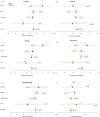Circulating testosterone and dehydroepiandrosterone are associated with individual motor unit features in untrained and highly active older men
- PMID: 34862585
- PMCID: PMC9213614
- DOI: 10.1007/s11357-021-00482-3
Circulating testosterone and dehydroepiandrosterone are associated with individual motor unit features in untrained and highly active older men
Abstract
Long-term exercise training has been considered as an effective strategy to counteract age-related hormonal declines and minimise muscle atrophy. However, human data relating circulating hormone levels with motor nerve function are scant. The aims of the study were to explore associations between circulating sex hormone levels and motor unit (MU) characteristics in older men, including masters athletes competing in endurance and power events. Forty-three older men (mean ± SD age: 69.9 ± 4.6 years) were studied based on competitive status. The serum concentrations of dehydroepiandrosterone (DHEA), total testosterone (T) and estradiol were quantified using liquid chromatography mass spectrometry. Intramuscular electromyographic signals were recorded from vastus lateralis (VL) during 25% of maximum voluntary isometric contractions and processed to extract MU firing rate (FR), and motor unit potential (MUP) features. After adjusting for athletic status, MU FR was positively associated with DHEA levels (p = 0.019). Higher testosterone and estradiol were associated with lower MUP complexity; these relationships remained significant after adjusting for athletic status (p = 0.006 and p = 0.019, respectively). Circulating DHEA was positively associated with MU firing rate in these older men. Higher testosterone levels were associated with reduced MUP complexity, indicating reduced electrophysiological temporal dispersion, which is related to decreased differences in conduction times along axonal branches and/or MU fibres. Although evident in males only, this work highlights the potential of hormone administration as a therapeutic interventional strategy specifically targeting human motor units in older age.
Keywords: Androgens; Circulating sex hormones; Electromyography; Masters athletes; Motor unit; Muscle.
© 2021. The Author(s).
Conflict of interest statement
MKR has received consulting fees and non-promotional lecture fees from Novo Nordisk and Cell Catapult. The companies have had no role in influencing the proposed study and are not expected to benefit from this work. The other authors declare no conflict of interests.
Figures




References
-
- Harridge, S.D. and N.R. Lazarus, Physical Activity, aging, and physiological function. physiology (Bethesda), 2017. 32(2): p. 152–161. 10.1152/physiol.00029.2016 - PubMed
Publication types
MeSH terms
Substances
Grants and funding
LinkOut - more resources
Full Text Sources
Research Materials

